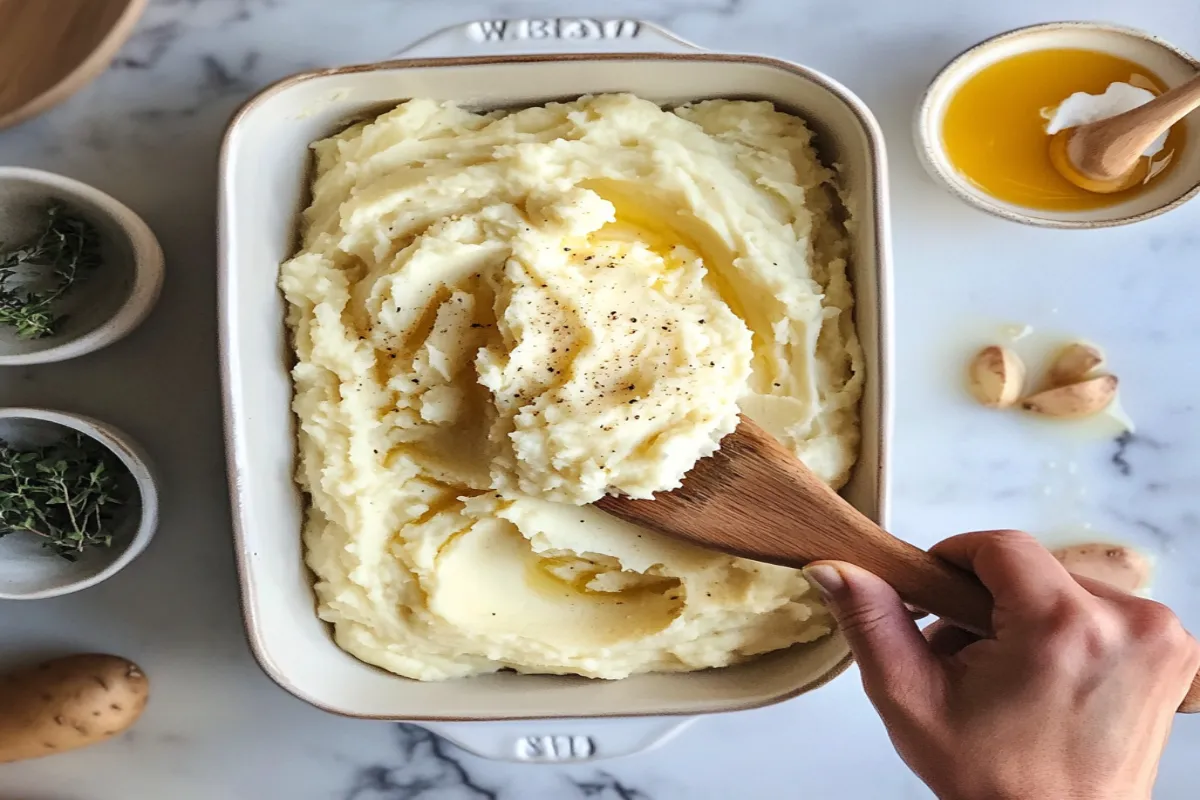Mashed potatoes are a universal favorite, enjoyed as a comfort food and a staple side dish across cultures and cuisines. The simplicity of mashed potatoes is part of their charm, but achieving the perfect texture—a light, fluffy, smooth consistency—can sometimes be tricky. Enter baking soda, a surprising yet effective addition that can take your mashed potatoes to the next level.
If you’ve been searching for ways to make your mashed potatoes fluffier without adding excessive amounts of butter or cream, baking soda might be the secret ingredient you need. In this guide, we’ll explore why baking soda works, how to use it in your recipe, and alternative methods for achieving the same effect. Plus, we’ll dive into common mistakes, the nutritional impact, and answer some frequently asked questions to ensure you have everything you need to create the best mashed potatoes ever.
The Science Behind Baking Soda in Potatoes
Baking soda, also known as sodium bicarbonate, is a chemical compound commonly used as a leavening agent in baking. When baking soda is exposed to heat and moisture, it produces carbon dioxide gas, which helps baked goods rise and become fluffy. But what does this have to do with mashed potatoes?
How Does Baking Soda Work in Potatoes?
Potatoes are packed with starches and a natural compound called pectin, which helps the potato cells stay firm and intact. When you add a small amount of baking soda to mashed potatoes, it breaks down the pectin, allowing the potato cells to soften. This makes the potatoes easier to mash and helps create that smooth, fluffy texture.
In addition to softening the potatoes, baking soda’s reaction with heat and moisture releases tiny bubbles of carbon dioxide. These bubbles create air pockets in the mashed potatoes, which contribute to the light, airy texture that we all love. For more insight into the science behind leavening agents like baking soda, visit The Science of Baking Soda in Cooking.
Benefits of Adding Baking Soda to Mashed Potatoes
Now that we understand the science behind baking soda in mashed potatoes, let’s take a look at the key benefits of adding this ingredient to your recipe.
1. Improved Fluffiness
The number one reason to add baking soda to your mashed potatoes is to make them fluffier. The breakdown of pectin and the release of carbon dioxide gas create a lighter, airier texture than traditional methods that rely solely on butter or cream.
Fluffy mashed potatoes are ideal for a wide range of dishes, whether you’re serving them alongside roast meats, vegetables, or even incorporating them into more elaborate recipes like shepherd’s pie or potato-topped casseroles.
2. Smoother Texture
One of the challenges in making mashed potatoes is avoiding lumps. By softening the potato cells, baking soda makes it easier to mash the potatoes evenly, resulting in a smooth, lump-free consistency. This means you won’t have to spend as much time mashing or risk overworking the potatoes, which can lead to a gummy or gluey texture.
3. Less Reliance on Fat
Traditional methods for achieving fluffy mashed potatoes often call for large amounts of butter or cream. While these ingredients certainly add richness, they can also make the dish feel heavy. By using baking soda, you can reduce the amount of fat needed to achieve the desired texture, resulting in a lighter, healthier dish without sacrificing fluffiness.
For more tips on enhancing the texture of potatoes in different recipes, check out this Bread and Cheese Guide for complementary pairings that elevate any meal.
Step-by-Step Guide: How to Add Baking Soda to Mashed Potatoes
Incorporating baking soda into your mashed potato recipe is simple, but it’s important to follow the right steps to ensure the best results. Here’s a step-by-step guide to making fluffy mashed potatoes with baking soda.
Step 1: Choose the Right Potatoes
The type of potato you use can have a big impact on the texture of your mashed potatoes. For the fluffiest results, choose starchy potatoes like Russets or Yukon Golds. These potatoes have a higher starch content, which works well with baking soda to create a lighter texture.
Step 2: Boil the Potatoes
Start by peeling and cutting the potatoes into evenly sized chunks. Place them in a pot of salted water and bring to a boil. Boil the potatoes for about 15-20 minutes, or until they are fork-tender.
Step 3: Drain and Add Baking Soda
Once the potatoes are fully cooked, drain them and return them to the pot. Add a small amount of baking soda—about 1/8 teaspoon per 4-6 servings. Be careful not to overdo it; too much baking soda can result in a bitter or soapy taste.
Step 4: Mash the Potatoes
Mash the potatoes using your preferred method. You can use a potato masher, ricer, or even an electric mixer. The key is to ensure the baking soda is evenly distributed throughout the potatoes, so that they become light and fluffy.
Step 5: Add Butter and Cream (Optional)
Once the potatoes are mashed, you can add butter, cream, or milk to taste. These ingredients will help make the potatoes creamier, but thanks to the baking soda, you won’t need to add as much to achieve a rich, smooth texture.
Step 6: Season and Serve
Finally, season the mashed potatoes with salt and pepper to taste. You can also add roasted garlic, fresh herbs, or grated cheese for extra flavor. Serve immediately while hot, and enjoy the fluffy, delicious result!
Alternatives to Baking Soda for Fluffy Mashed Potatoes
If you prefer not to use baking soda, there are other methods you can use to achieve a fluffy texture in your mashed potatoes.
1. Baking Powder
Baking powder is another leavening agent that can help make mashed potatoes fluffy. While it’s less commonly used than baking soda, it works in a similar way by releasing carbon dioxide gas when exposed to heat. If you choose to use baking powder, use the same amount as you would baking soda—about 1/8 teaspoon per 4-6 servings.
2. Potato Ricers
A potato ricer is a tool that mechanically presses the potatoes through small holes, breaking them into fine, even pieces. Using a ricer can help you achieve a smoother texture without adding any additional ingredients. While it won’t make the potatoes as light and airy as baking soda, it’s a great option if you prefer not to use additives.
3. Cream and Butter
If you prefer a more traditional approach, you can always rely on extra butter and cream to achieve a rich, creamy texture. While these ingredients won’t make the potatoes as light as baking soda, they add a delicious flavor and smooth consistency.
For another technique, see how Gordon Ramsay makes his mashed potatoes for extra inspiration.
Common Mistakes to Avoid
While adding baking soda to mashed potatoes is a simple process, there are a few common mistakes that can lead to disappointing results. Here’s what to avoid:
1. Using Too Much Baking Soda
A little baking soda goes a long way. Using too much can result in a bitter or soapy taste, which will ruin the flavor of your mashed potatoes. Stick to the recommended amount—about 1/8 teaspoon per 4-6 servings—to avoid this issue.
2. Inconsistent Mixing
It’s important to evenly distribute the baking soda throughout the potatoes. If the baking soda isn’t mixed well, some parts of the potatoes may be fluffier than others, while other parts remain dense. Take your time when mashing to ensure even consistency.
3. Adding Baking Soda Too Early
Make sure to add the baking soda after the potatoes have been boiled and drained, not during the boiling process. Adding it too early can cause it to lose its effectiveness, resulting in less fluffy potatoes.
Nutritional Impact of Baking Soda in Mashed Potatoes

One of the best things about adding baking soda to mashed potatoes is that it has virtually no impact on the nutritional content of the dish. The small amount used—usually 1/8 teaspoon—adds no significant calories, fat, or sodium.
In fact, using baking soda can allow you to reduce the amount of butter or cream you add to the potatoes, making the dish lighter and healthier overall. This makes baking soda a great option for those who are looking to enjoy their mashed potatoes without overloading on fat and calories.
For more health benefits and uses of baking soda in cooking, check out Benefits of Using Baking Soda in Food.
Frequently Asked Questions (FAQs)
Here are some common questions people have about using baking soda in mashed potatoes:
1. Why use baking soda instead of baking powder?
Baking soda reacts more effectively with the starches in potatoes, breaking down pectin to create a fluffy texture. Baking powder, on the other hand, requires an acid to activate, which isn’t present in most mashed potato recipes.
2. Will baking soda change the flavor of my mashed potatoes?
When used correctly, baking soda should not noticeably affect the flavor of your mashed potatoes. However, using too much can result in a bitter or soapy taste. Stick to the recommended amount for the best results.
3. Can I use baking soda in mashed potatoes if I’m lactose intolerant?
Yes! Since baking soda works by breaking down the starches in potatoes rather than relying on dairy, you can still achieve fluffy mashed potatoes without using milk or cream. Simply skip the dairy or use a lactose-free substitute.
4. How much baking soda should I use?
The recommended amount of baking soda is 1/8 teaspoon per 4-6 servings of mashed potatoes. This is enough to create a fluffy texture without altering the flavor.
Conclusion
Adding baking soda to mashed potatoes is a simple yet effective way to elevate this classic dish. By breaking down the pectin in the potatoes and creating air pockets, baking soda helps achieve a light, fluffy texture without the need for excessive butter or cream.
Whether you’re preparing mashed potatoes for a holiday feast or a weeknight dinner, this trick can help you create the perfect side dish every time. For more inspiration and variations, check out Why Put Vinegar in Mashed Potatoes and discover even more ways to enhance your potato dishes.

